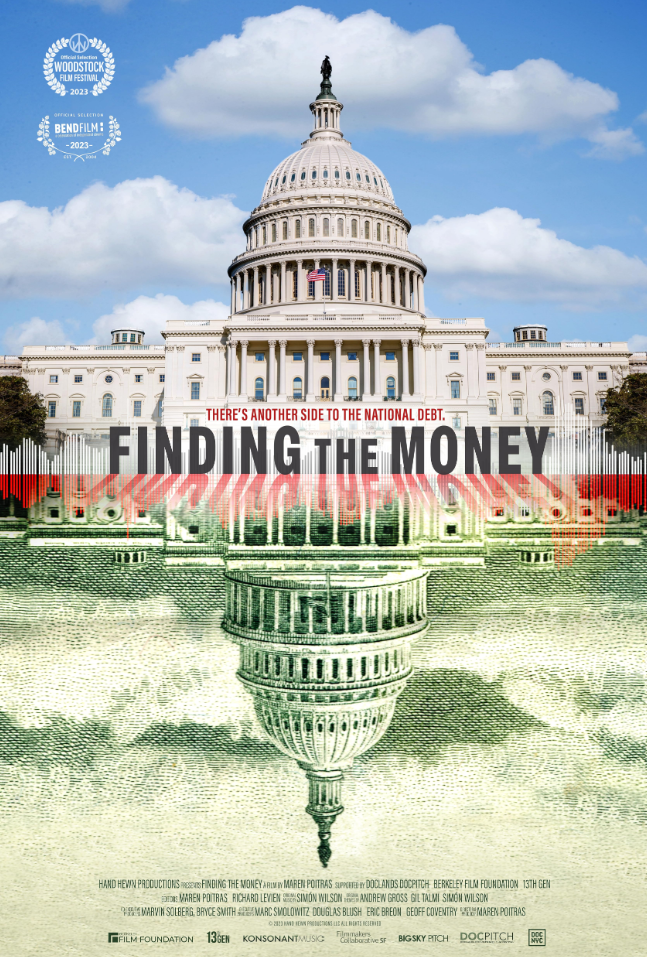The national debt. Those two words can spark heated debates, panicked headlines, and evoke images of a looming financial apocalypse. But what if there’s another way to look at it? “Finding the Money,” a thought-provoking documentary directed by Maren Poitras, dives into the controversial world of Modern Monetary Theory (MMT) and asks the question: can a new economic theory revolutionize how we tackle national debt and societal challenges?
WATCH THE TRAILER HERE!
Scheduled for a U.S. release on May 3rd, 2024, the film doesn’t have a typical Hollywood budget. Fueled by independent funding and a crowdfunding campaign, “Finding the Money” prioritizes sparking conversation over flashy visuals.
Director with a Keen Eye for Social Issues
Maren Poitras is no stranger to tackling complex social and political issues. Her previous documentaries, including the Oscar-nominated “Citizenfour,” have explored topics like government surveillance and Edward Snowden’s whistle-blowing. With “Finding the Money,” Poitras turns her lens inwards, examining a deeply ingrained economic principle and the potential for change.
Economists Take Center Stage
The film features a powerful trio leading the charge: Stephanie Kelton, Lua K. Yuille, and Mathew Forstater. Kelton, a prominent MMT advocate and former chief economist for Bernie Sanders’ Senate Budget Committee, serves as the film’s central figure. Yuille and Forstater, fellow MMT scholars, add depth and diverse perspectives to the discussion.
MMT: A Theory That Stirs the Pot
Modern Monetary Theory challenges traditional economic thinking. MMT argues that governments with their own fiat currency (like the U.S. dollar) can’t truly go bankrupt. They can always print more money to pay their bills, as long as inflation is kept in check. This flies in the face of conventional wisdom that emphasizes deficit reduction and a balanced budget.
A Historical Look at the U.S. Debt
The film delves into the history of the U.S. national debt, highlighting how it has grown significantly throughout history, yet the U.S. economy has continued to thrive. “Finding the Money” explores the disconnect between the ever-rising debt numbers and the perceived economic doom often associated with them.
MMT in Action: Investing in Our Future?
The documentary explores how MMT could be applied to address pressing social and environmental challenges. Imagine using this theory to fund massive investments in renewable energy, infrastructure upgrades, or universal healthcare. The film argues that with a focus on full employment and inflation control, such spending wouldn’t be reckless, but rather an investment in the country’s future.
Controversy Brews: A Theory Not Without Critics
MMT isn’t without its critics. Mainstream economists often question its feasibility, fearing runaway inflation and a devaluation of the currency. The film acknowledges these concerns and features interviews with opposing viewpoints, fostering a balanced discussion.
A Call for a New Conversation
“Finding the Money” isn’t a manifesto for MMT as much as it is a call for a paradigm shift in how we think about money and government spending. The film encourages viewers to question ingrained economic assumptions and consider alternative solutions. Will MMT become the new economic framework? Only time will tell.
But one thing is certain: “Finding the Money” is a documentary that will spark conversations, challenge existing narratives, and leave you questioning everything you thought you knew about national debt.
A Sobering Look at the Numbers: A ballooning Debt
To understand the current debate, “Finding the Money” takes a deep dive into the history of the U.S. national debt. In 1790, the very first year the debt was recorded, it stood at a modest $75 million. By 1860, on the eve of the Civil War, that number had risen to just $65 million. The war itself proved to be a turning point, pushing the debt to nearly $3 billion by 1865. Since then, the national debt has grown exponentially.
Fueling this growth have been a variety of factors, including World Wars I and II, the Great Depression, social welfare programs, and tax cuts. As of February 2024, the U.S. national debt sits at a staggering $34.4 trillion. That’s a number so large it’s hard to comprehend. To put it in perspective, if every single person in the United States owed an equal share of the debt, it would amount to over $105,000 per citizen.
A Historical Anomaly? Debt and Prosperity
Despite the alarming rise in debt, the film also highlights a curious historical anomaly. The U.S. economy has not only continued to function but has also thrived during periods of significant debt accumulation. “Finding the Money” explores this disconnect, challenging viewers to question the traditional narrative that equates national debt with economic doom.










+ There are no comments
Add yours